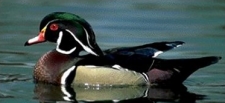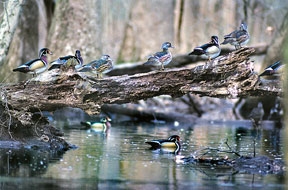Wildlife - Species

Species Specific Regulations
Wood Duck
Licenses: Hunting License required. Migratory Bird Hunting and Conservation Stamp (Federal Duck Stamp) that is validated by the hunter signing the stamp in ink across the face of the stamp.
Limits: Please see Migratory Bird Regulations for any game zones restrictions or Limitations.

Wood Duck (Aix sponsa)
Description
The wood duck's species name, sponsa, meaning "bride," refers to this bird's handsome appearance. Males have a dark green, purple, and blue-crested head with white face stripes and chin. The bill is reddish orange, the neck is white, and the chest is a deep chestnut color. The bird's flanks are barred with black and white, and its belly is white. Female wood ducks have less ornate plumage than their partners. They are mostly gray with a distinct white eye ring. Juveniles resemble females but are spotted below. Another distinctive characteristic of wood ducks is their habit of perching on snags or stumps near water. Wood ducks may measure 47 cm (18 in) from head to tail.
Preferred Habitat and Biology
The wood duck's breeding range extends over much of the continental United States and southern Canada. During the winter, the birds move south out of Canada into the lower 48 states. They are year-round residents of South Carolina, preferring to live in wooded swamps, bottomlands, marshes, and ponds.
The wood duck occurs year-round in South Carolina and is the only migratory duck species that breeds abundantly in all geographic regions of the state. In South Carolina, the mating season for this species typically begins in March with the search for a nesting site. Wood ducks are prevalent in the rivers and swamps of the ACE Basin, where the female constructs a nest of chips lined with down inside a tall tree or in man-made nesting boxes fitted with dome-shaped predator guards. The female lays eggs over a period of 12 days with hatching occurring after 28-30 days of incubation. Wood ducks typically raise one brood per year, but may have two in southern extremes of their range. Six to 15 whitish eggs are laid and incubated for 28-37 days. Young ducks leave the nest 56-70 days after hatching, jumping from the tree cavity or nest box to the ground or water below, where they forage on insects and invertebrates. They are protected by the hen for 8-10 weeks until they are able to fly. Ducklings are subject to predation by snapping turtles, alligators, bull frogs, snakes, and wading birds. Mortality may be as high as 50% from a clutch. The female may re-nest, with as many as three clutches initiated in an effort to have one successful brood (Beach 1989). Wood ducks feed upon seeds, berries, grains, aquatic invertebrates, and insects
.Species Significance
Sportsmen hunt these ornate and showy woodland ducks during the waterfowl season in autumn/winter. Hunting season is set by the South Carolina Department of Natural Resources each year by mid-August. The wood duck is a common resident in the ACE Basin.
References
Beach, V. 1989. Carolina's duck. SC Wildlife, 36(6): 27-35.
Bull, J. L. and J. Farrand, Jr. 1995. National Audubon Society Field Guide to North American Birds. Eastern Region. The Audubon Society field guide series. Alfred A. Knopf Inc., New York, NY.
Ehrlich, P. R., D. S. Dobkin, and D. Wheye. 1988. The birder's handbook: A field guide to the natural history of North American birds, including all species that regularly breed north of Mexico. Simon & Schuster, New York, NY.
National Geographic Society. 1987. Field guide to the birds of North America. Second edition. National Geographic Society, Washington, DC.
Sprunt, A., Jr. and E. B. Chamberlain. 1970. South Carolina bird life. University of South Carolina Press, Columbia, SC.
